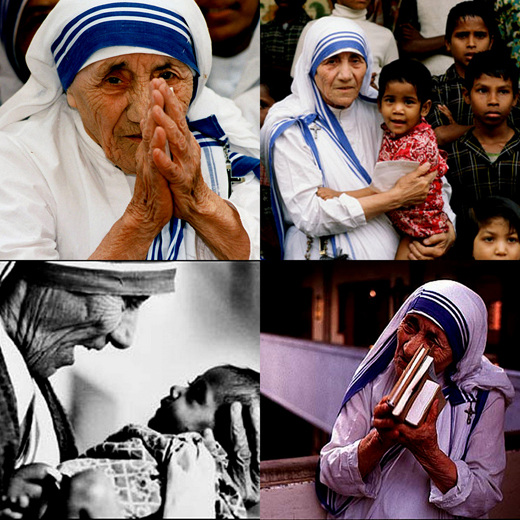Mercy, poor focus of Blessed Teresa’s canonization, events programme
www.mangaloretoday.com
Vatican City, August 13, 2016: The poor, the suffering and those who minister to them will be at the center of celebrations leading up to the canonization of Blessed Teresa of Kolkata at the Vatican.
The main event — the canonization Mass — will begin at 10:30 a.m. Sept. 4, the Vatican announced on Aug. 5.

A “family feast” for the poor, a musical, Masses and prayer vigils will precede her canonization, according to programs published by the Vatican and by the Missionaries of Charity, the order she founded.
Known as the “saint of the gutters,” Mother Teresa was revered for ministering to the sick and the dying in some of the world’s poorest neighborhoods.
Life Recap: Born Agnes Gonxha Bojaxhiu in 1910 to an ethnic Albanian family in Skopje, in what is now part of Macedonia, Mother Teresa went to India as a Sister of Loreto in 1929. Receiving what she described as a “call within a call,” she began her missionary work with the poor and laid the foundation for what would become the Missionaries of Charity.
Following her death in 1997, St. John Paul II waived the usual five-year waiting period and allowed the opening of the process to declare her sainthood. She was beatified in 2003.
The date of Mother Teresa’s canonization will coincide with the conclusion of the Year of Mercy pilgrimage for workers and ministers engaged in works of mercy.
Here are the main events planned around the canonization of Mother Teresa: Programme:
— Sept. 1, “feast for the poor and Missionaries of Charity family,” including a musical based on Mother Teresa’s life.
— Masses Sept. 2 in various languages in Rome’s Basilica of St. Anastasia al Palatino and veneration of her relics. In the evening, a prayer vigil with solemn eucharistic adoration will be held at Rome’s Basilica of St. John Lateran with Cardinal Agostino Vallini, the papal vicar of Rome, presiding.
— Catechesis Sept. 3 by Pope Francis for the jubilee celebration of workers and volunteers for mercy. In the evening, a prayer and musical meditation will be held at Rome’s Basilica of St. Andrea della Valle followed by veneration of Mother Teresa’s relics and Mass.
— Canonization Mass Sept. 4. Pilgrims will be able to venerate St. Teresa’s relics in the evening at the Basilica of St. John Lateran.
— Celebration Sept. 5 of a Mass of thanksgiving and the first feast of St. Teresa of Kolkata in St. Peter’s Basilica with Cardinal Pietro Parolin, Vatican secretary of state, presiding. Pilgrims will be able to venerate the relics of St. Teresa at St. John Lateran in the evening.
— Sept. 6, continuing veneration of the relics of St. Teresa at St. John Lateran.
— Sept. 7-8, veneration of the relics of St. Teresa of Kolkata at Rome’s Church of St. Gregory the Great, along with the possibility of visiting her room at the convent of St. Gregory.
Mother Teresa’s vision of Christianity
Mother Teresa has become a worldwide model for self-sacrifice and charity. She had a deep understanding of the teachings of Jesus Christ and she lived out these teachings as she served the world’s downtrodden. Because of her faith, Mother Teresa was able to intimately reflect on love, prayer, giving, service, poverty, forgiveness and more throughout her earthly ministry. She also had deep hope, abiding faith in God and a revolutionary vision of Christianity that we can still learn from today.

In the midst of the world’s poverty and pain, Mother Teresa showed the warm light of God’s love and compassion in us all. “You are the light of the world,” Jesus told His disciples. “Come, be my light.” Jesus similarly urged Mother Teresa in her mission. Throughout her life, she stands as a beacon of light reflecting the heart of God to those who seek Him. In the darkness of human suffering and sin, His signs of nearness and care were reflected. Mother Teresa recognized Jesus as the bread of life, that when He came into the world, He loved it so much that He gave His life for it. Jesus became the bread of life to satisfy our hunger for God and our hunger for love. Mother Teresa stressed the importance of not allowing anything to interfere with your love for Jesus. She believed that if you trust in Jesus as your joy and strength, temptations and difficulties will come, but nothing will break you.
Mother Teresa’s life was reflected not only in her work, but in her acts of service. She believed that we all have the duty to serve God where we feel called. Mother Teresa felt a calling by God to help individuals and to love each human being. She didn’t think in terms of crowds in general, but in terms of individuals. Mother Teresa believed in the power of person-to-person encounters because the person matters. Loving those around us is central to Christian life. Jesus had two primary commands for His followers. Second only to “love God” is “love your neighbor as yourself.” Our neighbors aren’t just the people that live next door to us. Our neighbors include the poor, disenfranchised and downtrodden. Mother Teresa answered this call through the fullness of her heart. She believed the fullness of our heart was a result of our actions: how we treat the leper, the dying person and the homeless. But she also believed that we need to be pure in heart to see Jesus in the person of the spiritually poorest. Her thought was that the more disfigured the image of the God was in that person, the greater our faith and devotion in seeking Jesus’ face and lovingly ministering to Him.
Long before everyone started talking about it, Mother Teresa and her sisters had gone to the margins and lived with the poor. She believed the more repugnant the work, the greater the effect of love and cheerful service. Mother Teresa shared that she would not have been able to be a Missionary of Charity had she not picked up a woman in the early part of her ministry who was eaten by rats. Feelings of repugnance are human. Mother Teresa believed that if we give our wholehearted, free service in spite of such feelings, we will become holy. The Bible tells us that we should be invested in the interest of others. Philippians 2:4 says, “Let each of you look not only to his own interests, but also to the interests of others.” This means the interests of others should be our interests too. We learn through Mother Teresa’s life the power of service. In the service to the poor, we are offered a magnificent opportunity to do something beautiful for God. When we give of ourselves with all our hearts to the poor, it is Christ whom we are serving.
Mother Teresa will always be remembered for what she said and what she did while on this earth. She started her work with no money, depending only on God to help her. Mother Teresa and her followers nursed the sick and dying, taught street children, gave shelter to the homeless, cared for the unloved and the lonely and proclaimed the Word of God. Rich and poor alike have felt inexplicably drawn into the mercy of God’s tender embrace by her example as a follower of Christ. Her selfless-love is a powerful example of what it means to love others as Christ loved us and a sign that God still loves the world today.
- Outstanding board results of St Theresa’s ICSE school, Bendur
- Eminent Konkani writer, KWAA President Ronald Sequeira no more
- Moodbidri: Pre-University student dies by suicide in her hostel room
- Mahila Congress stages protest; demands arrest of Prajwal Revanna
- Kasargod: Youth drowns in Payaswini river
- MIA authorities dismiss rumours on sex scandal accused Prajwal Revanna’s arrival
- 9,670 students appear for NEET in Dakshina Kannada
- Bantwal: 2 girls drown in Netravathi river
- New Mangalore Port Authority welcomes seventh cruise vessel of the season
- Mangaluru faces dwindling supply of water, braces for water rationing
- MCC training women civic workers to drive e-autorikshaws for garbage collection
- Prajwal Revanna obscene video case: Karnataka govt announces financial aid for rape victims
- Udupi Deputy Commissioner pushes for infrastructure improvements in Highways Review Meeting
- 11-Year-Old pune boy dies after Cricket ball hits his genitals
- ICICI Bank enables UPI payments in India for NRI customers
- Delhi Court denies bail to BRS leader K Kavitha in liquor ’scam’ case
- LS Elections 2024 phase 2: BJP, Congress again set for battle in 14 Karnataka seats
- Karnataka sex scandal: Probe team sets up helpline for survivors
- Several Ahmedabad schools get terror threat emails, bomb squad deployed
- Toxic tale: EU flagged over 400 Indian products
- Notice to 400 government colleges in Karnataka for not using funds
- ED raids Jharkhand minister’s secretary, seizes Rs 20 crore from his house help
- Terror threat to T20 World Cup from Pakistan, hosts West Indies assure safety
- Indian men’s 4x400m relay team qualifies for Olympics
- Indian-Origin Astronaut Sunita Williams set to fly into space again
- New residential complex for the judges inaugurated in Mangaluru
- Absconding accused nabbed after 8 years
- Truck with cylinders turns turtle in Beltangady
- Bhoota Kola artist dies of cardiac arrest
- Development of the country should be our goal: Ganesh Karnik
- Container truck gets stuck under Modankap railway bridge
- Truck crushes bike’s pillion rider near BC Road
- Head constable dies of heart attack
- Udupi: PDO dismissed over financial irregularities
- CREDAI to resume Skill Development Program for Construction Workers in Mangaluru
- John B Monteiro elected president of Rachana Catholic Chamber of Commerce & Industry
- Sudhanshu Rai elected district president of All College Student Association
- Chief Minister to visit Mangaluru, Udupi on August 1
- Nitte University awards PhD degree to Tina Sheetal D’Souza
- Sachitha Nandagopal honoured by CMTAI for Community Service
- CITY INFORMATION
- TRAVEL
- TOURIST INFORMATION
- HEALTH CARE
- MISCELLANEOUS




 Write Comment
Write Comment E-Mail To a Friend
E-Mail To a Friend Facebook
Facebook Twitter
Twitter  Print
Print 

